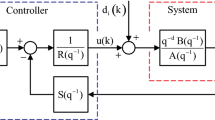Abstract
This paper focuses on the development of a simple adaptive and predictive control algorithm, used to regulate the effluent quality of an activated sludge treatment process. This control algorithm is based on the development of a linear incremental second order model which takes distinctively into account the main disturbances on the process. The model is employed to predict the effluent pollution over a finite horizon. Then, the control inputs are computed from the predictions and the desired output set point. The simulations conducted with a non linear process model showed that such a control strategy could improve the process performances by minimizing the effluent pollution and the energetic cost of the system.
Similar content being viewed by others
Author information
Authors and Affiliations
Additional information
Received: 28 October 1999
Rights and permissions
About this article
Cite this article
Charef, A., Ghauch, A. & Martin-Bouyer, M. An adaptive and predictive control strategy for an activated sludge process. Bioprocess Engineering 23, 529–534 (2000). https://doi.org/10.1007/s004499900191
Issue Date:
DOI: https://doi.org/10.1007/s004499900191




